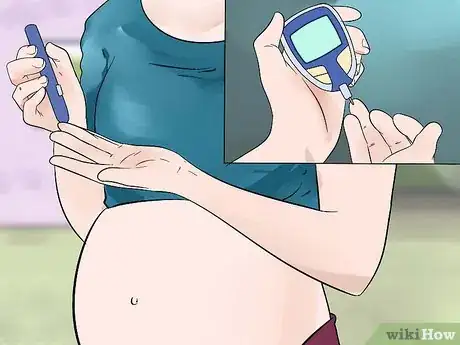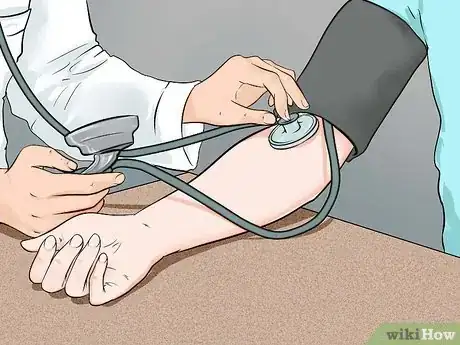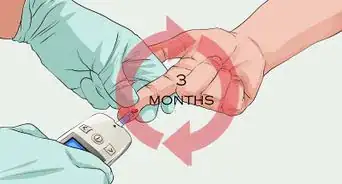This article was co-authored by Laura Marusinec, MD. Dr. Marusinec is a board certified Pediatrician at the Children's Hospital of Wisconsin, where she is on the Clinical Practice Council. She received her M.D. from the Medical College of Wisconsin School of Medicine in 1995 and completed her residency at the Medical College of Wisconsin in Pediatrics in 1998. She is a member of the American Medical Writers Association and the Society for Pediatric Urgent Care.
There are 30 references cited in this article, which can be found at the bottom of the page.
wikiHow marks an article as reader-approved once it receives enough positive feedback. In this case, 100% of readers who voted found the article helpful, earning it our reader-approved status.
This article has been viewed 285,341 times.
Diabetes is a metabolic disorder that affects your body's ability to either use or produce insulin, which how your body can use blood sugar for energy.[1] When your cells become resistant to insulin or your body doesn't make enough of it, your blood sugar levels rise, causing many of the short-term and long-term symptoms of diabetes. There are four different types of “sugar” diabetes: pre-diabetes, type 1, type 2, and gestational, although the majority of cases diagnosed each year are type 2 diabetes. In each of these types, there are both similar symptoms and symptoms that distinguish each type from the others.[2]
Steps
Recognizing the Risk Factors for Different Types of Diabetes
-
1Assess your risk for gestational diabetes. Gestational diabetes occurs in women who are pregnant. If you're at higher risk, you may be tested during your first prenatal visit and then again in the second trimester. Women at low risk will be tested in the second trimester, between weeks 24 and 28. Women who experience gestational diabetes have a higher risk of developing type 2 diabetes within ten years after the birth of their child. Risk factors include:[3]
- Pregnancy over the age of 25
- Family or personal health history of diabetes or pre-diabetes
- Being overweight at the time of pregnancy (a BMI of 30 or more)
- Women who are black, Hispanic, Native American, Asian, or Pacific Islander
- Third pregnancy or greater[4]
- Excessive intrauterine growth during pregnancy[5]
-
2Look for the risk factors of pre-diabetes. Pre-diabetes is a metabolic condition in which blood glucose (sugar) is higher than the normal range (70-99). Still, it's lower than recommended for treatment with medication to control blood glucose. The risk factors for pre-diabetes include:[6]
- Age 45 or older
- Being overweight
- Family history of type 2 diabetes
- Sedentary lifestyle
- High blood pressure
- A previous experience of gestational diabetes
- Having delivered a baby who was 9 pounds or greater
Advertisement -
3Evaluate your risk for type 2 diabetes. This is sometimes referred to a “full-blown” diabetes. In this condition, the body's cells have become resistant to the influence of leptin and insulin. This increases your blood sugar levels and causes the symptoms and long-term side effects of the disease. Risk factors for type 2 diabetes are similar to those for pre-diabetes, and include:[7]
- Over 45 years of age
- Overweight
- Physical inactivity
- High blood pressure
- History of gestational diabetes
- Delivered a baby over 9 pounds
- Family history of diabetes
- Chronic stress[8]
- You are black, Hispanic, Native American, Asian, or Pacific Islander
-
4Check for the risk factors of type 1 diabetes. Experts believe this condition is caused by a mix of genetic predisposition and environmental factors.[9]
- White people have a higher incidence of type 1 diabetes.
- Cold weather and viruses may trigger the development of type 1 diabetes in susceptible people. Living in a cold region, such as Scandinavia, Finland or the UK, also increases your risk slightly.
- Early childhood stress.[10]
- Children who were breast-fed and ate solids at a later age have a lower risk of developing type 1 diabetes even with the genetic predisposition.[11]
- If you have an identical twin with type 1 diabetes, you have about a 50% chance of also developing the disease.[12]
Watching for the Symptoms of Diabetes
-
1Get tested for gestational diabetes during pregnancy. Women with gestational diabetes often show no symptoms at all. As such, you should always request a test for it if you have the risk factors for gestational diabetes. This disease is especially dangerous because it affects both you and your baby. Because it can have long-term effects on your child, early diagnosis and treatment is important.[13]
- Some women feel very thirsty and need to urinate frequently. However, these are also common signs of any pregnancy.[14]
- Some women report that they feel uneasy or uncomfortable after eating foods that are high in carbohydrates or sugar.
-
2Be vigilant for symptoms of pre-diabetes. Like with gestational diabetes, there are often very few symptoms of pre-diabetes.[15] Diabetes symptoms are caused by very high blood sugar levels, which people with pre-diabetes don't have. If you have the risk factors for it, you must be vigilant, get tested regularly, and be on the lookout for subtle symptoms. Pre-diabetes can develop into diabetes if left untreated.
- You may have pre-diabetes if you have "acanthosis nigricans" on specific areas of your body. This is simply thick, darkened patches of skin that most often appears on the armpits, neck, elbow, knees and knuckles.[16]
- You might experience a feeling of uneasiness after eating a meal high in carbohydrates or sugars.
- Your doctor may test for pre-diabetes if you have elevated cholesterol levels, high blood pressure, or other hormonal imbalances, such as metabolic syndrome, or if you are overweight.
-
3Evaluate your symptoms for type 2 diabetes. Whether you have the risk factors for the condition or not, you can still develop type 2 diabetes. Be aware of your health condition and watch for these signs that your blood sugar may be elevated:[17]
- Unexplained weight loss
- Blurred vision or other noticeable changes in your vision
- Increased thirst from high blood sugar
- Increased need to urinate
- Fatigue and drowsiness, even with adequate sleep
- Tingling or numbness in the feet or hands
- Frequent or recurring infections in the bladder, skin or mouth
- Shakiness or hunger in the middle of the morning or afternoon
- Cuts and scrapes appear to heal more slowly
- Dry, itchy skin or unusual bumps or blisters
- Feeling more hungry than usual.
-
4Suspect type 1 diabetes with sudden symptoms. Although most patients develop this type of diabetes during childhood or adolescence, it can also develop well into adulthood. The symptoms of type 1 diabetes may appear suddenly or be subtly present for a long time, and can include:[18]
- Excessive thirst
- Increased urination
- Vaginal yeast infections in women
- Irritability
- Blurred vision
- Unexplained weight loss
- Unusual bedwetting in children
- Extreme hunger
- Fatigue and weakness
-
5Seek immediate medical attention when necessary. People often ignore the symptoms of diabetes, allowing the condition to progress to a dangerous degree. The symptoms of type 2 diabetes appear slowly over time. But with type 1 diabetes, your body can very suddenly stop making insulin. You will experience more severe symptoms that are potentially life-threatening unless treated immediately. These include:[19]
- Deep rapid breathing
- Flushed face, dry skin and mouth
- Fruity breath
- Nausea and vomiting
- Stomach pain
- Confusion or lethargy
Getting Tested for Diabetes
-
1See a doctor immediately if you experience symptoms. Your doctor will need to perform several tests to determine if you have diabetes. If you do, in fact, have diabetes or pre-diabetes, you will need to follow-up with regular treatment by following your doctor's instructions.
-
2Get a blood glucose test. The blood glucose test does exactly what it sounds like it does: it tests the amount of glucose (sugar) in your blood. This will be used to determine whether you have diabetes or are at risk of developing it. This test will done under one of three circumstances:[20]
- A fasting glucose blood test is done after you haven't had anything to eat for at least eight hours. If it is an emergency, your doctor will do a random blood glucose test regardless of whether you have eaten recently.
- A two-hour postprandial test is done two hours after eating a specific number of carbohydrates to test your body's ability to handle the sugar load. This test is usually done in a hospital so they can measure the number of carbs eaten before the test.
- An oral glucose tolerance test requires you to drink a high glucose fluid. They will test your blood and urine every 30-60 minutes to measure how well the body is able to tolerate the additional load. This test is not done if the doctor suspects type 1 diabetes.
-
3Submit to an A1C test. This blood test is also called the glycated hemoglobin test. It measures the amount of sugar attached to the body's hemoglobin molecules. This measurement gives the doctor a good indication of your average blood sugar measurements over the past 30 to 60 days.[21]
-
4Have a ketone test done if necessary. Ketone is found in the blood when an insulin shortage forces the body to break down fat for energy. It comes out through the urine, most often in patients with type 1 diabetes. Your doctor may recommend a blood or urine test for ketone:[22]
- If your blood sugar is higher than 240 mg/dL.
- During an illness such as pneumonia, stroke or heart attack.
- If you experience nausea and vomiting.
- During pregnancy.
-
5Request routine testing. If you have diabetes or are at risk of developing it, it's important to monitor your health and blood sugar levels regularly. High blood sugar will cause damage to the microvascular (micro-blood vessels) in your organs. This damage can cause problems throughout the body. To monitor your overall health, get:[23]
- An annual eye exam
- Evaluation for diabetic neuropathy in the feet
- Regular (at least annual) blood pressure monitoring
- Annual kidney testing
- Dental cleaning every 6 months
- Regular cholesterol testing
- Regular visits with your primary care doctor or endocrinologist
Treating Diabetes
-
1Make lifestyle choices with pre-diabetes and type 2 diabetes. These conditions often develop because of the choices we make, rather than our genetics. By changing those choices, you can reduce your blood sugar or prevent the development of the condition.[24]
-
2Eat fewer carbohydrates. When your body metabolizes carbs they turn to sugar, and the body needs more insulin to use it. Cut down on grains, pastas, candies, sweets, soda and other foods that are high in simple carbohydrates, as your body processes these too quickly and they can cause a spike in blood sugar.[25] Talk to your doctor or a registered dietitian about incorporating complex carbohydrates with plenty of fiber and a low-GI (glycemic index) rating into your diet. Low-GI, complex carbs include:[26]
- Beans and legumes
- Non-starchy vegetables (most vegetables, except foods like parsnips, plantains, potatoes, pumpkin, squash, peas, corn)
- Most fruits (except for certain fruits such as dried fruits, bananas, and grapes)
- Whole grains, such as steel cut oats, bran, whole-grain pasta, barley, bulgur, brown rice, quinoa
- Don't limit your fiber. Instead, subtract it off the total carbohydrates (per serving size) on the Nutrition label. Fiber is not digested and actually prevents blood sugar spikes, resulting in better control of blood sugar levels.
-
3Maintain a healthy weight. Insulin resistance goes up with an increasing waistline. When you can maintain a more healthy weight you can stabilize your blood sugar more easily. A combination of diet and exercise will help keep your weight in a healthy range. Get at least 30 minutes of exercise a day to help your body to use blood glucose without insulin. This also helps you maintain a healthy weight and improves your quality of sleep.[27]
-
4
-
5Do not rely on medication alone. If you have type 1, type 2, or gestational diabetes, your doctor may recommend medication in addition to lifestyle changes. However, you cannot rely on medication alone to manage the disease. It must be used to support the major changes caused by your lifestyle changes.[29]
-
6Take oral hypoglycemic medications if you have type 2 or gestational diabetes. These medications are taken in pill form, and reduce blood sugar throughout the course of the day. Examples include Metformin (biguanides), sulfonylureas, Meglitinides, Alpha-glucosidase inhibitors and combination pills.[30]
-
7Administer insulin injections if you have type 1 diabetes. This is really the only effective treatment for type 1, though it can also be used for type 2 and gestational diabetes. There are four different types of insulin available for this treatment. Your physician will decide which will be most effective in controlling your blood sugar. You may take just one, or use a combination of types at different times of the day. Your doctor may also recommend an insulin pump to maintain your insulin levels 24 hours a day.[31]
- Rapid acting insulin is taken before meals, and often in combination with long acting insulin.
- Short acting insulin is taken about 30 minutes before meals, and usually in combination with longer acting insulin.
- Intermediate acting insulin is usually taken twice a day, and lowers glucose when the short or rapid acting insulin stops working.
- Long acting insulin can be used to cover the time when the rapid and short acting insulin stops working.
-
8Eat more foods high in healthy proteins and fats. Although once thought to be the source of heart disease, the healthy fats found in avocados and seafood are now known to be good sources of fuel. They may help to stabilize blood sugar and reduce your food cravings. Always avoid trans-fats, as these are the bad fats.[32]
-
9Ask about new treatments for diabetes. There are some new medications that can help lower blood sugar in people with type 2 diabetes. One type of medicine, called an SGLT inhibitor, helps your kidneys get rid of extra glucose from the blood and send it out in your urine. Examples of SGLT inhibitors include Canagliflozin (Invokana) and Dapagliflozin (Farxiga). [33]
- Ask your doctor if these drugs are right for you.
Expert Q&A
-
QuestionWhat is a normal glucose level?
 Laura Marusinec, MDDr. Marusinec is a board certified Pediatrician at the Children's Hospital of Wisconsin, where she is on the Clinical Practice Council. She received her M.D. from the Medical College of Wisconsin School of Medicine in 1995 and completed her residency at the Medical College of Wisconsin in Pediatrics in 1998. She is a member of the American Medical Writers Association and the Society for Pediatric Urgent Care.
Laura Marusinec, MDDr. Marusinec is a board certified Pediatrician at the Children's Hospital of Wisconsin, where she is on the Clinical Practice Council. She received her M.D. from the Medical College of Wisconsin School of Medicine in 1995 and completed her residency at the Medical College of Wisconsin in Pediatrics in 1998. She is a member of the American Medical Writers Association and the Society for Pediatric Urgent Care.
Board Certified Pediatrician For most healthy adults, a normal fasting blood glucose level is between 70 and 100. But it can still be okay up to 130 fasting, and up to about 180 after eating.
For most healthy adults, a normal fasting blood glucose level is between 70 and 100. But it can still be okay up to 130 fasting, and up to about 180 after eating. -
QuestionI have been experiencing excessive thirst, increased urination, extreme hunger and a change in my vision. Are these signs of diabetes?
 Laura Marusinec, MDDr. Marusinec is a board certified Pediatrician at the Children's Hospital of Wisconsin, where she is on the Clinical Practice Council. She received her M.D. from the Medical College of Wisconsin School of Medicine in 1995 and completed her residency at the Medical College of Wisconsin in Pediatrics in 1998. She is a member of the American Medical Writers Association and the Society for Pediatric Urgent Care.
Laura Marusinec, MDDr. Marusinec is a board certified Pediatrician at the Children's Hospital of Wisconsin, where she is on the Clinical Practice Council. She received her M.D. from the Medical College of Wisconsin School of Medicine in 1995 and completed her residency at the Medical College of Wisconsin in Pediatrics in 1998. She is a member of the American Medical Writers Association and the Society for Pediatric Urgent Care.
Board Certified Pediatrician These are very concerning symptoms for possibly having diabetes. You should see your doctor right away.
These are very concerning symptoms for possibly having diabetes. You should see your doctor right away.
Warnings
- Do not try to self-treat diabetes at home. The long term effects of diabetes can include kidney disease, blindness, loss of hands, feet or legs, diabetic neuropathy and death. You can reduce your medications through changing your lifestyle choices and under the guidance of your physician.⧼thumbs_response⧽
References
- ↑ https://medlineplus.gov/diabetes.html
- ↑ https://www.cdc.gov/diabetes/basics/diabetes.html
- ↑ https://www.niddk.nih.gov/health-information/diabetes/overview/what-is-diabetes/gestational/symptoms-causes
- ↑ http://www.ncbi.nlm.nih.gov/pubmed/18979449
- ↑ http://www.ncbi.nlm.nih.gov/pubmed/18979449
- ↑ https://www.cdc.gov/diabetes/prevention/about-prediabetes.html
- ↑ https://www.niddk.nih.gov/health-information/diabetes/overview/risk-factors-type-2-diabetes
- ↑ http://spectrum.diabetesjournals.org/content/18/2/121.full
- ↑ https://www.cdc.gov/diabetes/basics/risk-factors.html
- ↑ https://www.heart.org/en/news/2018/11/06/stress-may-increase-type-2-diabetes-risk-in-women
- ↑ https://www.diabetes.org/diabetes/gestational-diabetes/diabetes-breastfeeding
- ↑ http://care.diabetesjournals.org/content/24/5/838.full
- ↑ https://www.nhs.uk/conditions/gestational-diabetes/
- ↑ https://americanpregnancy.org/healthy-pregnancy/pregnancy-complications/gestational-diabetes/
- ↑ https://www.cdc.gov/diabetes/basics/prediabetes.html
- ↑ https://www.aad.org/public/diseases/a-z/diabetes-warning-signs
- ↑ https://medlineplus.gov/ency/article/000313.htm
- ↑ https://www.diabetes.org/diabetes/type-1/symptoms
- ↑ https://www.diabetes.org/diabetes/type-1/symptoms
- ↑ https://medlineplus.gov/ency/article/003482.htm
- ↑ https://www.cdc.gov/diabetes/managing/managing-blood-sugar/a1c.html
- ↑ https://medlineplus.gov/lab-tests/ketones-in-urine/
- ↑ https://medlineplus.gov/ency/patientinstructions/000082.htm
- ↑ https://www.health.harvard.edu/blog/healthy-lifestyle-can-prevent-diabetes-and-even-reverse-it-2018090514698
- ↑ http://www.hsph.harvard.edu/nutritionsource/carbohydrates/carbohydrates-and-blood-sugar/
- ↑ https://www.diabetes.org/healthy-living/recipes-nutrition/understanding-carbs
- ↑ https://www.niddk.nih.gov/health-information/diabetes/overview/diet-eating-physical-activity
- ↑ https://www.fda.gov/tobacco-products/health-effects-tobacco-use/cigarette-smoking-risk-factor-type-2-diabetes
- ↑ https://my.clevelandclinic.org/health/diseases/7104-diabetes-mellitus-an-overview#management-and-treatment
- ↑ https://www.ncbi.nlm.nih.gov/books/NBK482386/
- ↑ https://www.cdc.gov/diabetes/basics/type-1-4-ways-to-take-insulin.html
- ↑ https://www.niddk.nih.gov/health-information/diabetes/overview/diet-eating-physical-activity
- ↑ https://www.fda.gov/drugs/postmarket-drug-safety-information-patients-and-providers/sodium-glucose-cotransporter-2-sglt2-inhibitors
About This Article
To know if you have type 2 diabetes, watch out for common symptoms, like unexplained weight loss, blurry vision or vision change, increased thirst and need to urinate, fatigue, and tingling or numbness in your hands or feet. If you're over 45, overweight, and physically inactive, you're at a higher risk of developing type 2 diabetes. To know if you have type 1 diabetes, which usually develops during childhood or adolescence, look out for excessive thirst and urination, irritability, blurred vision, extreme hunger, and unexplained weight loss. To learn how to get tested for diabetes, scroll down!

















































































Medical Disclaimer
The content of this article is not intended to be a substitute for professional medical advice, examination, diagnosis, or treatment. You should always contact your doctor or other qualified healthcare professional before starting, changing, or stopping any kind of health treatment.
Read More...